University Audit, Assurance, and Compliance Report Analysis
VerifiedAdded on 2019/11/19
|8
|1053
|450
Report
AI Summary
This report provides a detailed analysis of the financial performance and risk factors of Double Ink Printers Ltd (DIPL). It begins with an analytical procedure using financial ratios to assess profitability, liquidity, and solvency over a three-year period. The analysis reveals declining profitability, improved liquidity, and increasing financial risks. The report then identifies inherent risks, including financial risk due to increased debt and information technology risks. It also examines fraud risk factors, such as debt agreements and the control environment, highlighting potential manipulations. The report suggests corroboration between financial figures to detect manipulation and emphasizes the importance of examining inventory and aligning purchases. The report concludes by referencing several academic sources to support its findings.
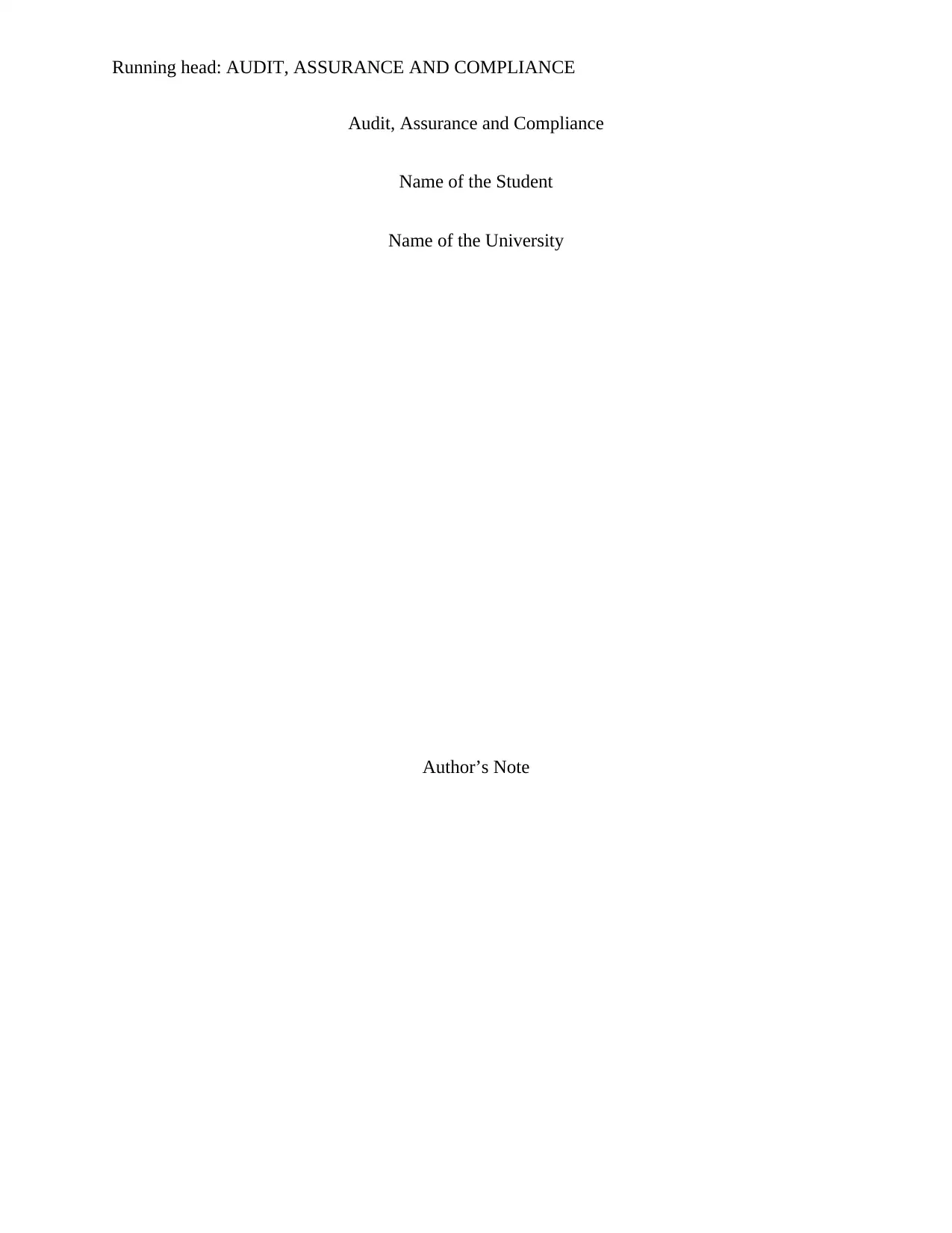
Running head: AUDIT, ASSURANCE AND COMPLIANCE
Audit, Assurance and Compliance
Name of the Student
Name of the University
Author’s Note
Audit, Assurance and Compliance
Name of the Student
Name of the University
Author’s Note
Paraphrase This Document
Need a fresh take? Get an instant paraphrase of this document with our AI Paraphraser
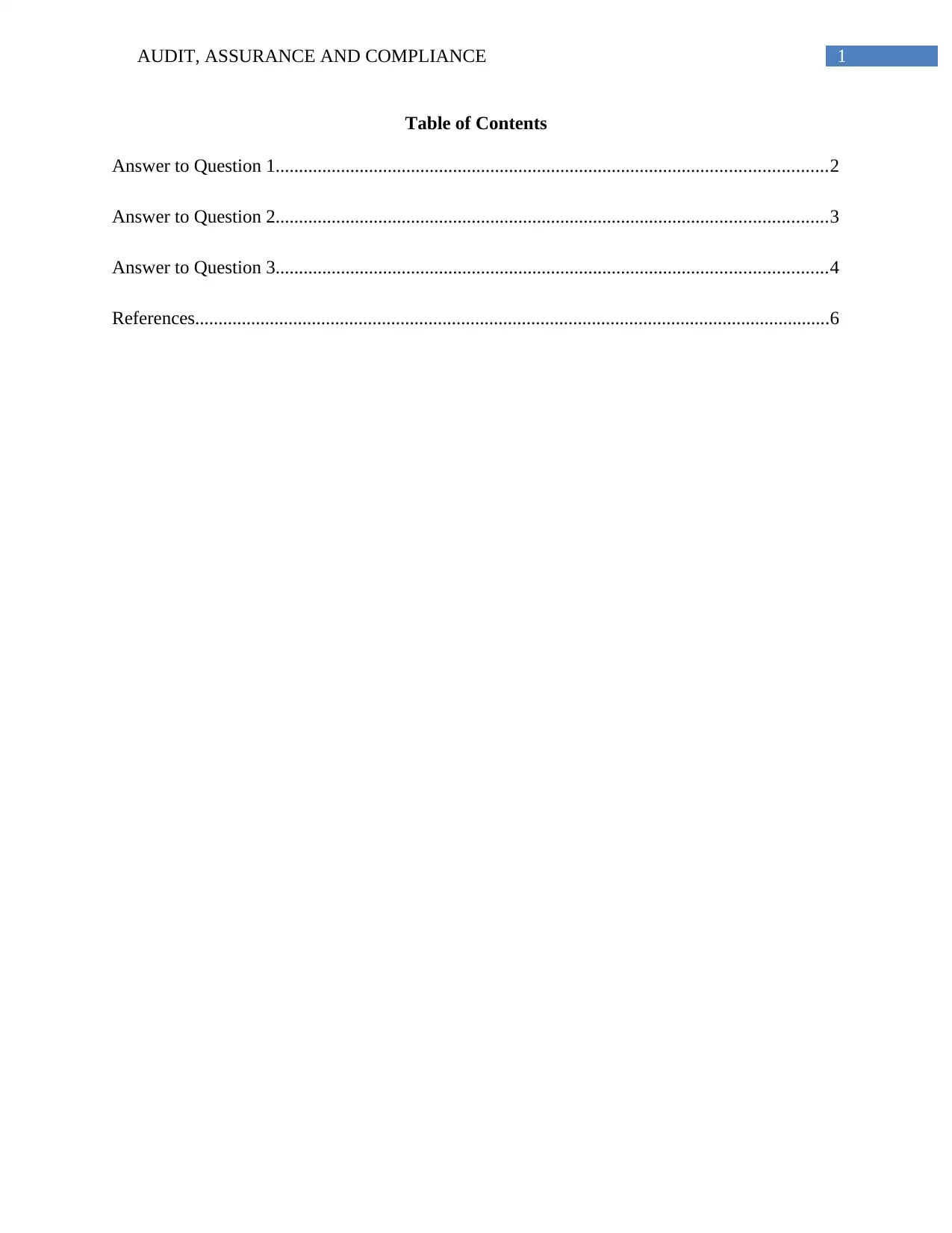
1AUDIT, ASSURANCE AND COMPLIANCE
Table of Contents
Answer to Question 1......................................................................................................................2
Answer to Question 2......................................................................................................................3
Answer to Question 3......................................................................................................................4
References........................................................................................................................................6
Table of Contents
Answer to Question 1......................................................................................................................2
Answer to Question 2......................................................................................................................3
Answer to Question 3......................................................................................................................4
References........................................................................................................................................6
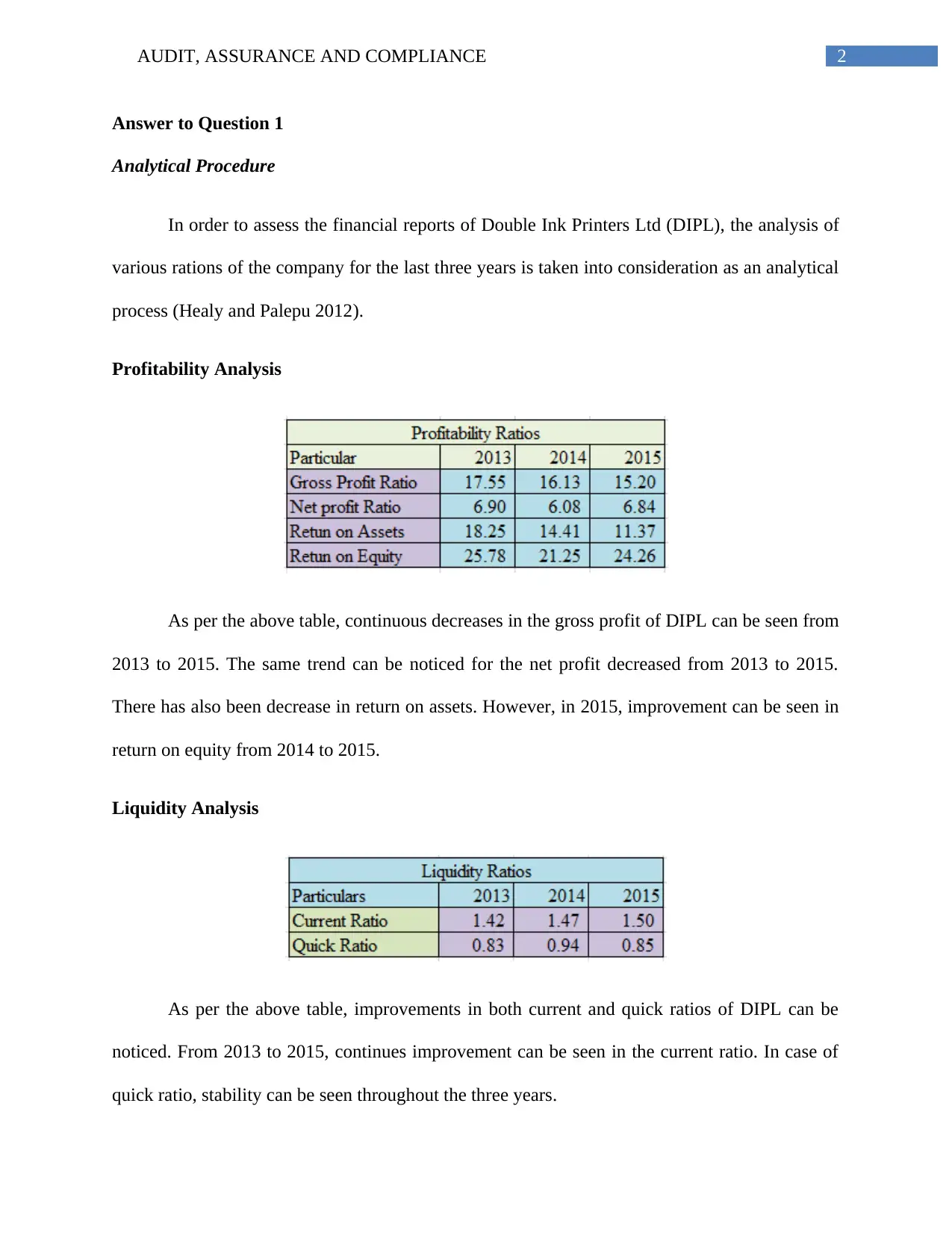
2AUDIT, ASSURANCE AND COMPLIANCE
Answer to Question 1
Analytical Procedure
In order to assess the financial reports of Double Ink Printers Ltd (DIPL), the analysis of
various rations of the company for the last three years is taken into consideration as an analytical
process (Healy and Palepu 2012).
Profitability Analysis
As per the above table, continuous decreases in the gross profit of DIPL can be seen from
2013 to 2015. The same trend can be noticed for the net profit decreased from 2013 to 2015.
There has also been decrease in return on assets. However, in 2015, improvement can be seen in
return on equity from 2014 to 2015.
Liquidity Analysis
As per the above table, improvements in both current and quick ratios of DIPL can be
noticed. From 2013 to 2015, continues improvement can be seen in the current ratio. In case of
quick ratio, stability can be seen throughout the three years.
Answer to Question 1
Analytical Procedure
In order to assess the financial reports of Double Ink Printers Ltd (DIPL), the analysis of
various rations of the company for the last three years is taken into consideration as an analytical
process (Healy and Palepu 2012).
Profitability Analysis
As per the above table, continuous decreases in the gross profit of DIPL can be seen from
2013 to 2015. The same trend can be noticed for the net profit decreased from 2013 to 2015.
There has also been decrease in return on assets. However, in 2015, improvement can be seen in
return on equity from 2014 to 2015.
Liquidity Analysis
As per the above table, improvements in both current and quick ratios of DIPL can be
noticed. From 2013 to 2015, continues improvement can be seen in the current ratio. In case of
quick ratio, stability can be seen throughout the three years.
⊘ This is a preview!⊘
Do you want full access?
Subscribe today to unlock all pages.

Trusted by 1+ million students worldwide
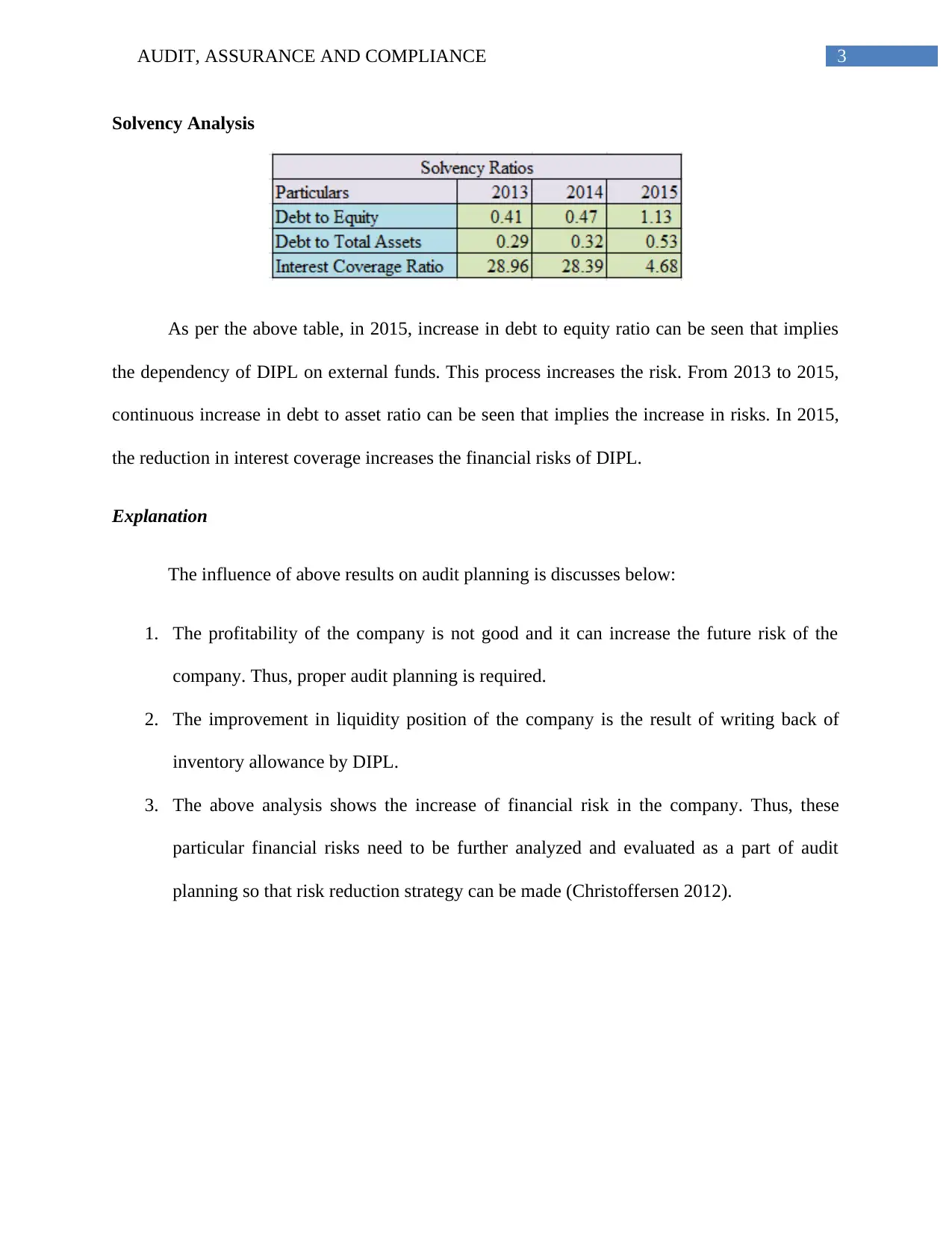
3AUDIT, ASSURANCE AND COMPLIANCE
Solvency Analysis
As per the above table, in 2015, increase in debt to equity ratio can be seen that implies
the dependency of DIPL on external funds. This process increases the risk. From 2013 to 2015,
continuous increase in debt to asset ratio can be seen that implies the increase in risks. In 2015,
the reduction in interest coverage increases the financial risks of DIPL.
Explanation
The influence of above results on audit planning is discusses below:
1. The profitability of the company is not good and it can increase the future risk of the
company. Thus, proper audit planning is required.
2. The improvement in liquidity position of the company is the result of writing back of
inventory allowance by DIPL.
3. The above analysis shows the increase of financial risk in the company. Thus, these
particular financial risks need to be further analyzed and evaluated as a part of audit
planning so that risk reduction strategy can be made (Christoffersen 2012).
Solvency Analysis
As per the above table, in 2015, increase in debt to equity ratio can be seen that implies
the dependency of DIPL on external funds. This process increases the risk. From 2013 to 2015,
continuous increase in debt to asset ratio can be seen that implies the increase in risks. In 2015,
the reduction in interest coverage increases the financial risks of DIPL.
Explanation
The influence of above results on audit planning is discusses below:
1. The profitability of the company is not good and it can increase the future risk of the
company. Thus, proper audit planning is required.
2. The improvement in liquidity position of the company is the result of writing back of
inventory allowance by DIPL.
3. The above analysis shows the increase of financial risk in the company. Thus, these
particular financial risks need to be further analyzed and evaluated as a part of audit
planning so that risk reduction strategy can be made (Christoffersen 2012).
Paraphrase This Document
Need a fresh take? Get an instant paraphrase of this document with our AI Paraphraser
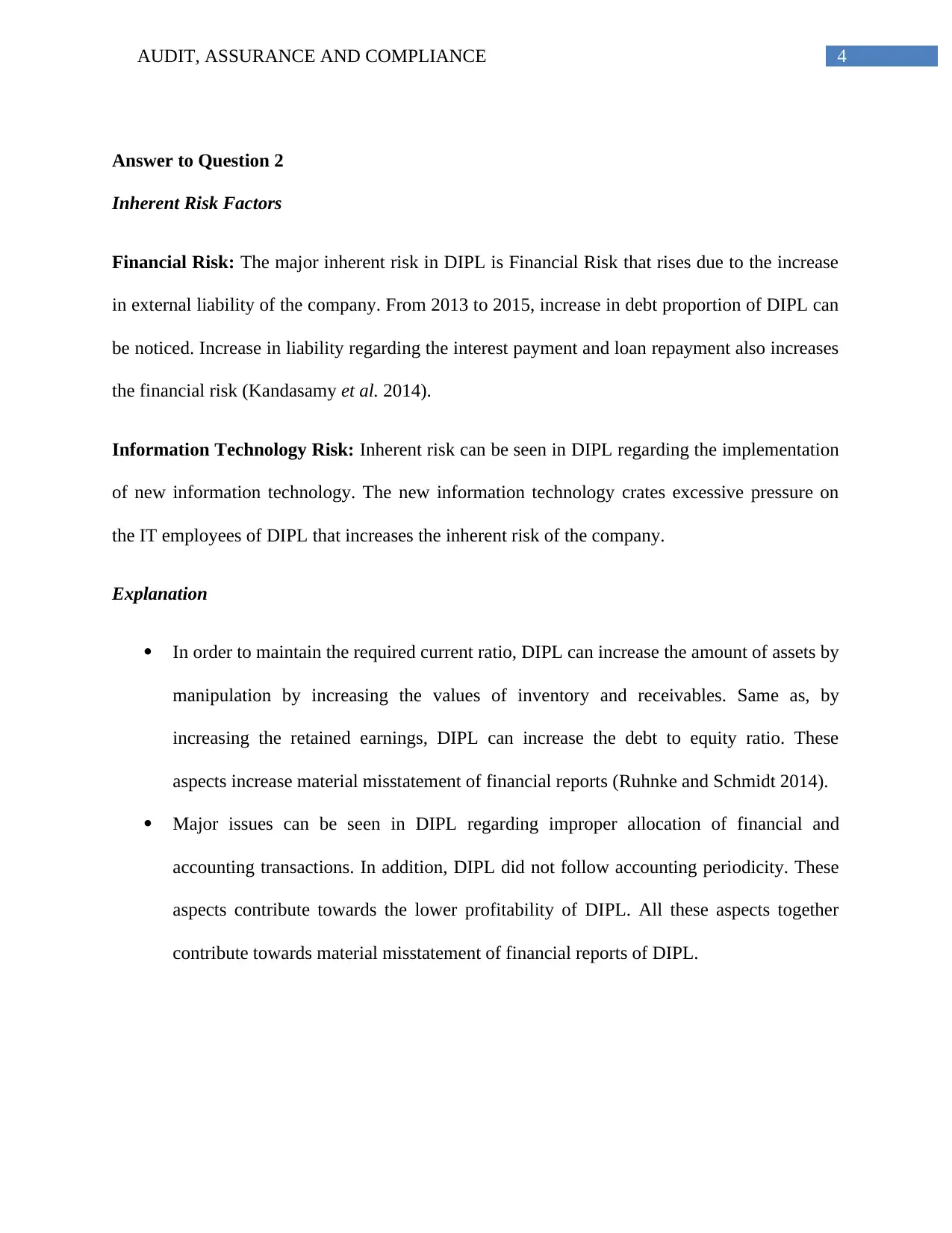
4AUDIT, ASSURANCE AND COMPLIANCE
Answer to Question 2
Inherent Risk Factors
Financial Risk: The major inherent risk in DIPL is Financial Risk that rises due to the increase
in external liability of the company. From 2013 to 2015, increase in debt proportion of DIPL can
be noticed. Increase in liability regarding the interest payment and loan repayment also increases
the financial risk (Kandasamy et al. 2014).
Information Technology Risk: Inherent risk can be seen in DIPL regarding the implementation
of new information technology. The new information technology crates excessive pressure on
the IT employees of DIPL that increases the inherent risk of the company.
Explanation
In order to maintain the required current ratio, DIPL can increase the amount of assets by
manipulation by increasing the values of inventory and receivables. Same as, by
increasing the retained earnings, DIPL can increase the debt to equity ratio. These
aspects increase material misstatement of financial reports (Ruhnke and Schmidt 2014).
Major issues can be seen in DIPL regarding improper allocation of financial and
accounting transactions. In addition, DIPL did not follow accounting periodicity. These
aspects contribute towards the lower profitability of DIPL. All these aspects together
contribute towards material misstatement of financial reports of DIPL.
Answer to Question 2
Inherent Risk Factors
Financial Risk: The major inherent risk in DIPL is Financial Risk that rises due to the increase
in external liability of the company. From 2013 to 2015, increase in debt proportion of DIPL can
be noticed. Increase in liability regarding the interest payment and loan repayment also increases
the financial risk (Kandasamy et al. 2014).
Information Technology Risk: Inherent risk can be seen in DIPL regarding the implementation
of new information technology. The new information technology crates excessive pressure on
the IT employees of DIPL that increases the inherent risk of the company.
Explanation
In order to maintain the required current ratio, DIPL can increase the amount of assets by
manipulation by increasing the values of inventory and receivables. Same as, by
increasing the retained earnings, DIPL can increase the debt to equity ratio. These
aspects increase material misstatement of financial reports (Ruhnke and Schmidt 2014).
Major issues can be seen in DIPL regarding improper allocation of financial and
accounting transactions. In addition, DIPL did not follow accounting periodicity. These
aspects contribute towards the lower profitability of DIPL. All these aspects together
contribute towards material misstatement of financial reports of DIPL.
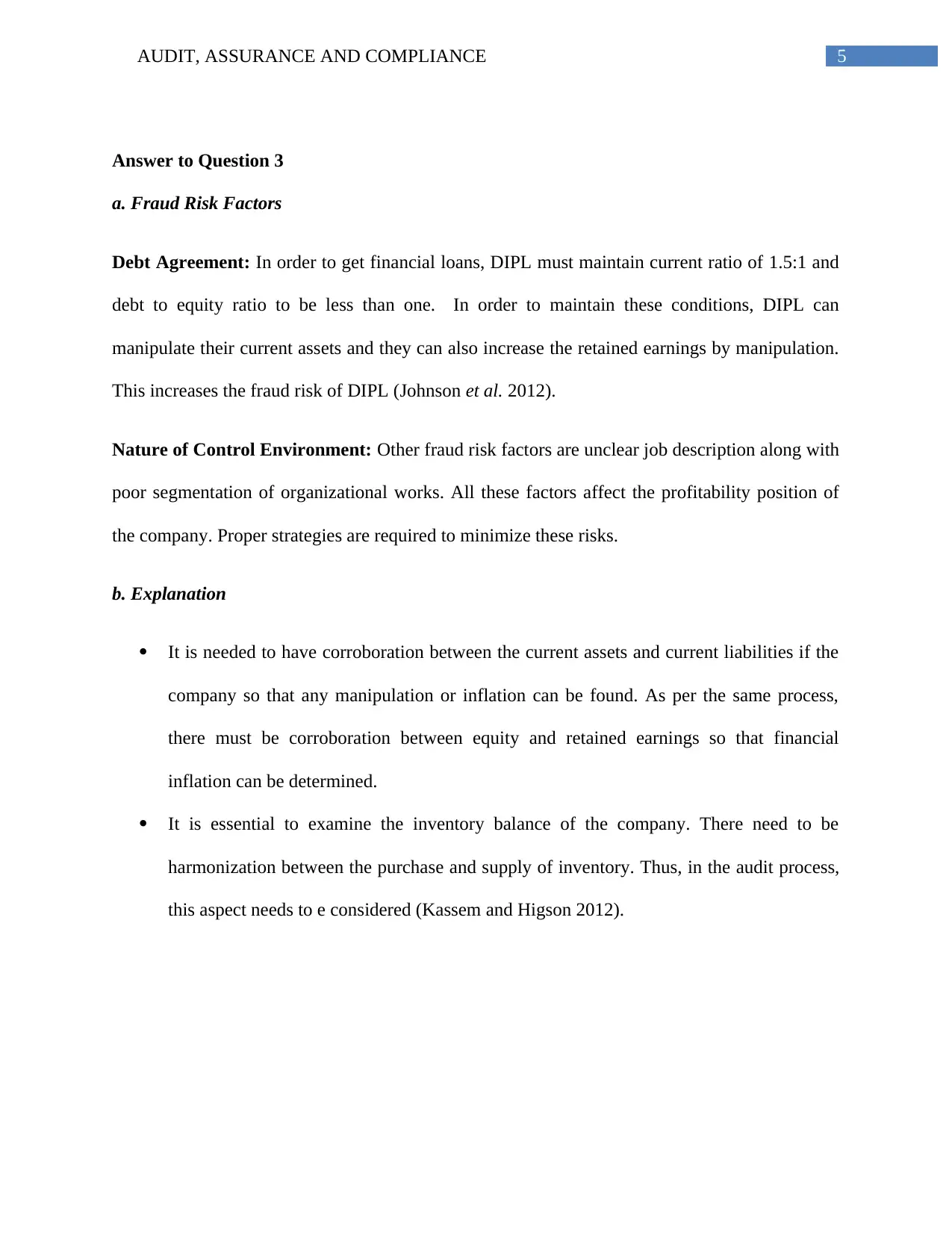
5AUDIT, ASSURANCE AND COMPLIANCE
Answer to Question 3
a. Fraud Risk Factors
Debt Agreement: In order to get financial loans, DIPL must maintain current ratio of 1.5:1 and
debt to equity ratio to be less than one. In order to maintain these conditions, DIPL can
manipulate their current assets and they can also increase the retained earnings by manipulation.
This increases the fraud risk of DIPL (Johnson et al. 2012).
Nature of Control Environment: Other fraud risk factors are unclear job description along with
poor segmentation of organizational works. All these factors affect the profitability position of
the company. Proper strategies are required to minimize these risks.
b. Explanation
It is needed to have corroboration between the current assets and current liabilities if the
company so that any manipulation or inflation can be found. As per the same process,
there must be corroboration between equity and retained earnings so that financial
inflation can be determined.
It is essential to examine the inventory balance of the company. There need to be
harmonization between the purchase and supply of inventory. Thus, in the audit process,
this aspect needs to e considered (Kassem and Higson 2012).
Answer to Question 3
a. Fraud Risk Factors
Debt Agreement: In order to get financial loans, DIPL must maintain current ratio of 1.5:1 and
debt to equity ratio to be less than one. In order to maintain these conditions, DIPL can
manipulate their current assets and they can also increase the retained earnings by manipulation.
This increases the fraud risk of DIPL (Johnson et al. 2012).
Nature of Control Environment: Other fraud risk factors are unclear job description along with
poor segmentation of organizational works. All these factors affect the profitability position of
the company. Proper strategies are required to minimize these risks.
b. Explanation
It is needed to have corroboration between the current assets and current liabilities if the
company so that any manipulation or inflation can be found. As per the same process,
there must be corroboration between equity and retained earnings so that financial
inflation can be determined.
It is essential to examine the inventory balance of the company. There need to be
harmonization between the purchase and supply of inventory. Thus, in the audit process,
this aspect needs to e considered (Kassem and Higson 2012).
⊘ This is a preview!⊘
Do you want full access?
Subscribe today to unlock all pages.

Trusted by 1+ million students worldwide
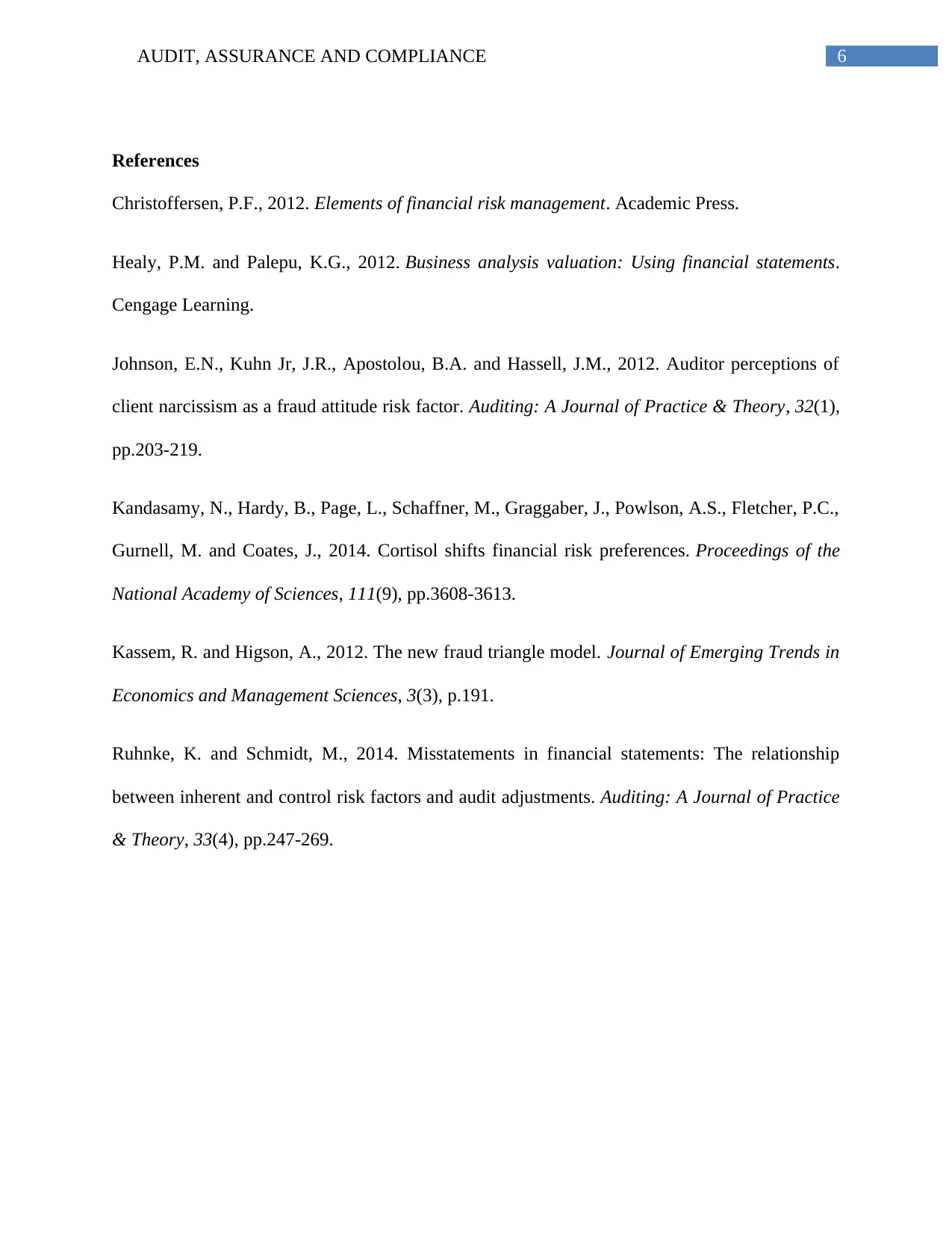
6AUDIT, ASSURANCE AND COMPLIANCE
References
Christoffersen, P.F., 2012. Elements of financial risk management. Academic Press.
Healy, P.M. and Palepu, K.G., 2012. Business analysis valuation: Using financial statements.
Cengage Learning.
Johnson, E.N., Kuhn Jr, J.R., Apostolou, B.A. and Hassell, J.M., 2012. Auditor perceptions of
client narcissism as a fraud attitude risk factor. Auditing: A Journal of Practice & Theory, 32(1),
pp.203-219.
Kandasamy, N., Hardy, B., Page, L., Schaffner, M., Graggaber, J., Powlson, A.S., Fletcher, P.C.,
Gurnell, M. and Coates, J., 2014. Cortisol shifts financial risk preferences. Proceedings of the
National Academy of Sciences, 111(9), pp.3608-3613.
Kassem, R. and Higson, A., 2012. The new fraud triangle model. Journal of Emerging Trends in
Economics and Management Sciences, 3(3), p.191.
Ruhnke, K. and Schmidt, M., 2014. Misstatements in financial statements: The relationship
between inherent and control risk factors and audit adjustments. Auditing: A Journal of Practice
& Theory, 33(4), pp.247-269.
References
Christoffersen, P.F., 2012. Elements of financial risk management. Academic Press.
Healy, P.M. and Palepu, K.G., 2012. Business analysis valuation: Using financial statements.
Cengage Learning.
Johnson, E.N., Kuhn Jr, J.R., Apostolou, B.A. and Hassell, J.M., 2012. Auditor perceptions of
client narcissism as a fraud attitude risk factor. Auditing: A Journal of Practice & Theory, 32(1),
pp.203-219.
Kandasamy, N., Hardy, B., Page, L., Schaffner, M., Graggaber, J., Powlson, A.S., Fletcher, P.C.,
Gurnell, M. and Coates, J., 2014. Cortisol shifts financial risk preferences. Proceedings of the
National Academy of Sciences, 111(9), pp.3608-3613.
Kassem, R. and Higson, A., 2012. The new fraud triangle model. Journal of Emerging Trends in
Economics and Management Sciences, 3(3), p.191.
Ruhnke, K. and Schmidt, M., 2014. Misstatements in financial statements: The relationship
between inherent and control risk factors and audit adjustments. Auditing: A Journal of Practice
& Theory, 33(4), pp.247-269.
Paraphrase This Document
Need a fresh take? Get an instant paraphrase of this document with our AI Paraphraser
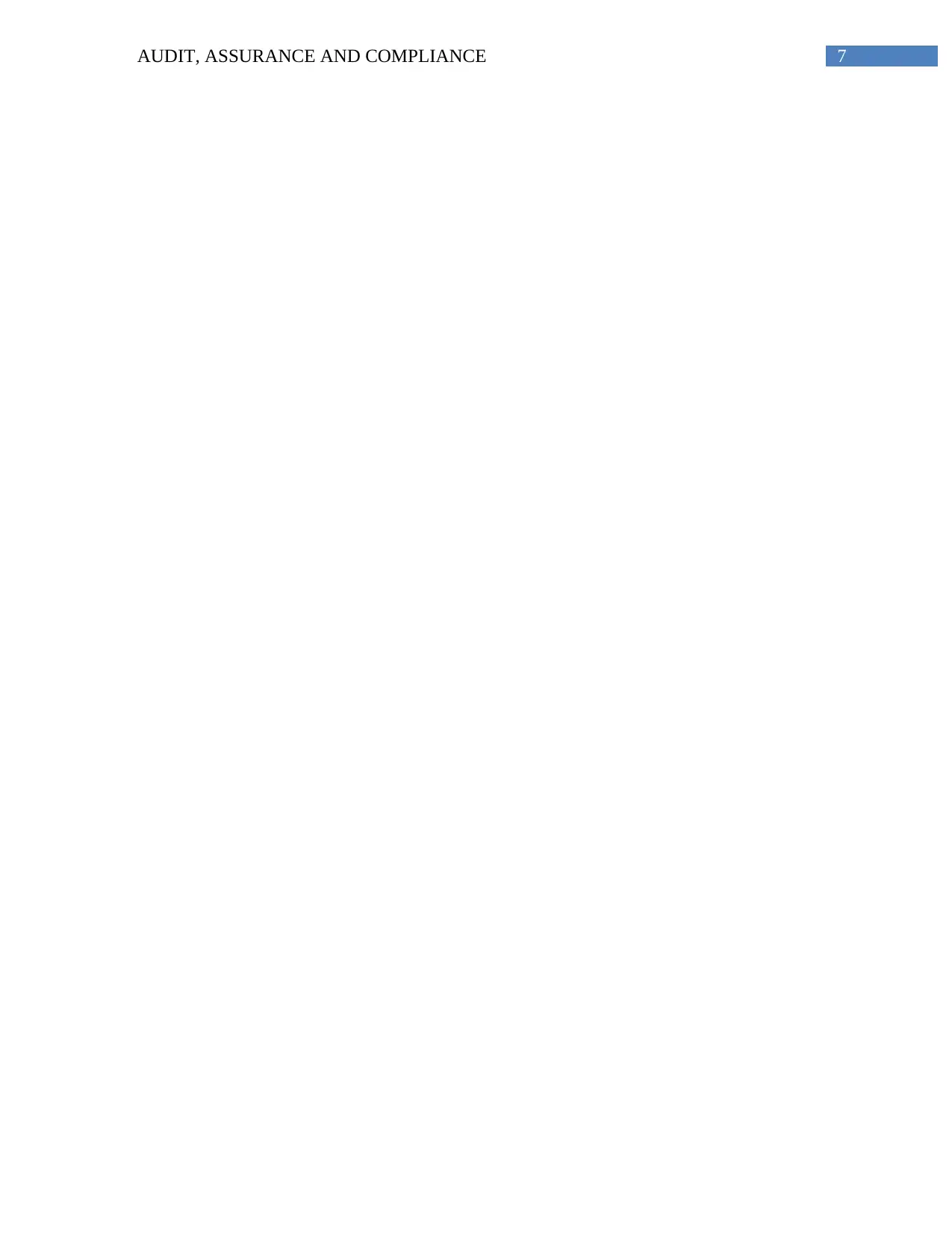
7AUDIT, ASSURANCE AND COMPLIANCE
1 out of 8
Related Documents
Your All-in-One AI-Powered Toolkit for Academic Success.
+13062052269
info@desklib.com
Available 24*7 on WhatsApp / Email
![[object Object]](/_next/static/media/star-bottom.7253800d.svg)
Unlock your academic potential
Copyright © 2020–2025 A2Z Services. All Rights Reserved. Developed and managed by ZUCOL.





